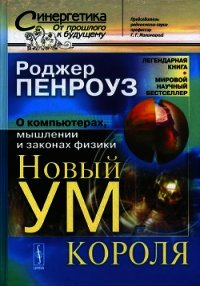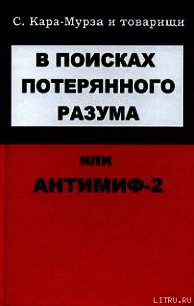Тени разума. В поисках науки о сознании - Пенроуз Роджер (книги без регистрации полные версии txt) 📗
[178] Guccione, S. (1993). Mind the truth: Penrose's new step in the Godelian argument. Behavioural and Brain Sciences, 16, 612-613.
[179] Haag, R. (1992). Local quantum physics: fields, particles, algebras. Springer-Verlag, Berlin.
[180] Hadamard, J. (1945). The psychology of invention in the mathematical field. Princeton University Press.
[181] Hallett, M. (1984). Cantorian set theory and limitation of size. Clarendon Press, Oxford.
[182] Hameroff, S. R. (1974). Chi: a neural hologram? Am. J. Clin. Med., 2(2), 163-170.
[183] Hameroff, S. R. (1987). Ultimate computing. Biomolecular consciousness and nano-technology. North-Holland, Amsterdam.
[184] Hameroff, S. R., Watt, R. С (1982). Information in processing in microtubules. /. Theor. Biol., 98, 549-561.
[185] Hameroff, S.R., Watt, R.C. (1983). Do anesthetics act by altering electron mobility? Anesth. Analg., 62, 936-940.
[186] Hameroff, S.R., Rasmussen, S., Mansson, B. (1988). Molecular automata in microtubles: basic computational logic of the living state? В сб. Artificial Life, SFI studies in the sciences of complexity (ed. C. Langton). Addison-Wesley, New York.
[187] Hanbury Brown, R., Twiss, R.Q. (1954). A new type of interferometer for use in radio astronomy. Phil. Mag., 45, 663-682.
[188] Hanbury Brown, R., Twiss, R.Q. (1956). The question of correlation between photons in coherent beams of light. Nature, 177, 27-29.
[189] Harel, D. (1987). Algorithmics. The spirit of computing. Addison-Wesley, New York.
[190] Hawking, S.W. (1975). Particle creation by Black Holes. Commun. Math. Phys., 43, 199-220.
[191] Hawking, S.W. (1982). Unpredictability of quantum gravity. Commun. Math. Phys., 87, 395-415.
[192] Hawking, S.W., Israel, W. (ed.) (1987). 300 years of gravitation. Cambridge University Press.
[193] Hebb, D. O. (1949). The organization of behaviour. Wiley, New York.
[194] Hecht, S., Shlaer, S., Pirenne, M.H. (1941). Energy, quanta and vision. Journal of General Physiology, 25, 821-840.
[195] Herbert, N. (1993). Elemental mind. Human consciousness and the new physics. Dutton Books, Penguin Publishing.
[196] Heyting, A. (1956). Intuitionism: an introduction. North-Holland, Amsterdam.
[197] Heywood, P., Redhead, M.L. G. (1983). Nonlocality and the Kochen—Specker Paradox. Found. Phys., 13, 481-499.
[198] Hodges, A. P. (1983). Alan Turing: the enigma. Burnett Books and Hutchinson, London; Simon and Schuster, New York.
[199] Hodgkin, D., Houston, A. I. (1990). Selecting for the con in consciousness. Behavioural and Brain Sciences, 13 (4), 668.
[200] Hodgson, D. (1991). Mind matters: consciousness and choice in a quantum world. Clarendon Press, Oxford.
[201] Hofstadter, D.R. (1979). Godel, Escher, Bach: an eternal golden braid. Harvester Press, Hassocks, Essex.
[202] Hofstadter, D.R. (1981). A conversation with Einstein's brain. В сб. The mind's / (ed. D. R. Hofstadter, D. Dennett). Basic Books; Penguin, Harmondsworth, Middlesex.
[203] Hofstadter, D.R., Dennett, D. С (ed.)(1981). The mind's I. Basic Books; Penguin, Harmondsworth, Middlesex.
[204] Home, D. (1994). A proposed new test of collapse-induced quantum nonlocality. Preprint.
[205] Home, D., Nair, R. (1994). Wave function collapse as a nonlocal quantum effect. Phys. Lett., A187, 224-226.
[206] Home, D., Selleri, F. (1991). Bell's Theorem and the EPR Paradox. Rivista del Nuovo Cimento, 14, N. 9.
[207] Hopfield, J.J. (1982). Neural networks and physical systems with emergent collective computational abilities. Proc. Natl. Acad. Sci., 79, 2554-2558.
[208] Hsu, F.-H., Anantharaman, Т., Campbell, M., Nowatzyk, A. (1990). A grandmaster chess machine. Scientific American, 263.
[209] Huggett, S.A., Tod, K.P. (1985). An introduction to twistor theory. London Math. Soc. student texts. Cambridge University Press.
[210] Hughston, L.P., Jozsa, R., Wootters, W. K. (1993). A complete classification of quantum ensembles having a given density matrix. Phys. Letters, A183, 14-18.
[211] Isham, С J. (1989). Quantum gravity. В сб. The new physics (ed. P. C. W. Davies), 70-93. Cambridge University Press.
[212] Isham, С J. (1994). Prima facie questions in quantum gravity. В сб. Canonical relativity: classical and quantum (ed. J. Ehlers, H. Friedrich). Springer-Veriag, Berlin.
[213] Jibu, M, Hagan, S., Pribram, K.., Hameroff, S.R., Yasue, K. (1994). Quantum optical coherence in cytoskeletal microtubules: implications for brain function. Bio. Systems (готовится к печати).
[214] Johnson-Laird, P.N. (1983). Mental models. Cambridge University Press.
[215] Johnson-Laird, P.N. (1987). How could consciousness arise from the computations of the brain? В сб. Mindwaves: thoughts on intelligence, identity and consciousness (ed. C. Blakemore, S. Greenfield). Blackwell, Oxford.
[216] Karolyhazy, F. (1966). Gravitation and quantum mechanics of macroscopic bodies. Nuo. Cim. A, 42, 390-402.
[217] Karolyhazy, F. (1974). Gravitation and quantum mechanics of macroscopic bodies. Magyar Fizikai Polyoirat, 12, 24.
[218] Karolyhazy, F, Frenkel, A., Lukacs, B. (1986). On the possible role of gravity on the reduction of the wave function. В сб. Quantum concepts in space and time (ed. R. Penrose, C.J. Isham). Oxford University Press.
[219] Kasumov, A.Y., Kislov, N.A., Khodos, I.I. (1993). Can the observed vibration of a cantilever of supersmall mass be explained by quantum theory? Microsc. Microanal. Microstruct., 4, 401-406.
[220] Kentridge, R. W. (1990). Parallelism and patterns of thought. Behavioural and Brain Sciences, 13 (4), 670.
[221] Khalfa, J. (ed.) (1994). What is intelligence? The Darwin College lectures. Cambridge University Press.
[222] Klarner, D.A. (1981). My life among the Polyominoes. В сб. The mathematical gardner (ed. D. A. Klarner). Prindle, Weber and Schmidt, Boston, MA; Wadsworth Int., Belmont, CA.
[223] Kleene, S. C. (1952). Introduction to metamathematics. North-Holland, Amsterdam, van Nostrand, New York.
[224] Klein, M.V., Furtak, Т.Е. (1986). Optics, 2nd edn. Wiley, New York.
[225] Kochen, S., Specker, E.R (1967). The problem of hidden variables in quantum mechanics. /. Math. Mech., 17, 59-88.
[226] Kohonen, T. (1984). Self-organization and associative memory. Springer-Verlag, New York.
[227] Komar, A.B. (1969). Qualitative features of quantized gravitation. Int. J. Theor. Phys., 2, 157-160.
[228] Koruga, D. (1974). Microtubule screw symmetry: packing of spheres as a latent bioinformation code. Ann. NY Acad. Sci., 466, 953-955.
[229] Koruga, D., Hameroff, S., Withers, J., Loutfy, R., Sundareshan, M. (1993). Fullerene C6o- History, physics, nanobiology, nanotechnology. North-Holland, Amsterdam.
[230] Kosko, B. (1994). Fuzzy thinking: the new science of fuzzy logic. Harper Collins, London.
[231] Kreisel, G. (1960). Ordinal logics and the characterization of informal concepts of proof. Proc. of the Internal. Cong, of Mathematics, Aug. 1958. Cambridge University Press.
[232] Kreisel, G. (1967). Informal rigour and completeness proofs. В сб. Problems in the philosophy of mathematics (ed. I. Lakatos), 138-186. North-Holland, Amsterdam.
[233] Lagues, M., Xiao Ming Xie, Tebbji, H., Xiang Zhen Xu, Mairet, V, Hatterer, C, et al. (1993). Evidence suggesting superconductivity at 250 К in a sequentially deposited cuprate film. Science, 262, 1850-1851.
[234] Lander, L. J., Parkin, T. R. (1966). Counterexample to Euler's conjecture on sums of like powers. Bull. Amer. Math. Soc, 72, 1079.
[235] Leggett, A.J. (1984). Schrodinger's cat and her laboratory cousins. Contemp. Phys., 25 (6), 583.
[236] Lewis, D. (1969). Lucas against mechanism. Philosophy, 44, 231-233.
[237] Lewis, D. (1989). Lucas against mechanism II. Can. J. Philos., 9, 373-376.




